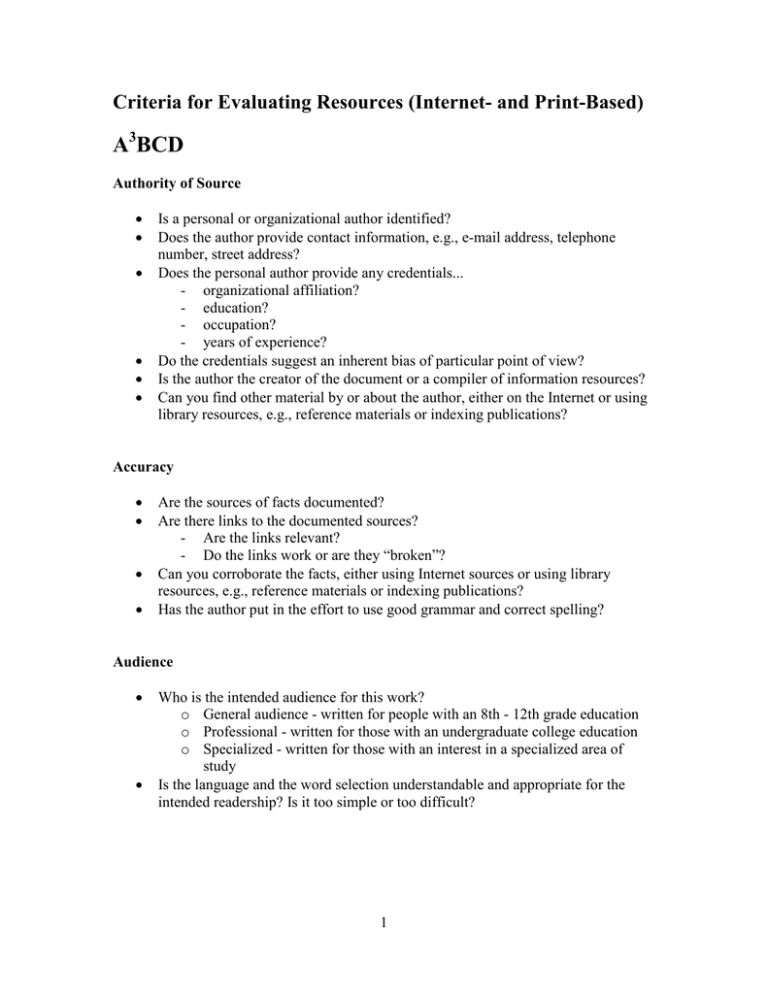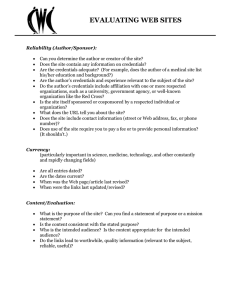A BCD Criteria for Evaluating Resources (Internet- and Print-Based)
advertisement

Criteria for Evaluating Resources (Internet- and Print-Based) A3BCD Authority of Source • • • • • • Is a personal or organizational author identified? Does the author provide contact information, e.g., e-mail address, telephone number, street address? Does the personal author provide any credentials... - organizational affiliation? - education? - occupation? - years of experience? Do the credentials suggest an inherent bias of particular point of view? Is the author the creator of the document or a compiler of information resources? Can you find other material by or about the author, either on the Internet or using library resources, e.g., reference materials or indexing publications? Accuracy • • • • Are the sources of facts documented? Are there links to the documented sources? - Are the links relevant? - Do the links work or are they “broken”? Can you corroborate the facts, either using Internet sources or using library resources, e.g., reference materials or indexing publications? Has the author put in the effort to use good grammar and correct spelling? Audience • • Who is the intended audience for this work? o General audience - written for people with an 8th - 12th grade education o Professional - written for those with an undergraduate college education o Specialized - written for those with an interest in a specialized area of study Is the language and the word selection understandable and appropriate for the intended readership? Is it too simple or too difficult? 1 Bias/Point of View • • • • • • What is the purpose of the document... - to inform/explain? - to persuade/advocate a position? - to sell? Does this reflect a particular bias in viewpoint? Who is the intended audience, e.g., professionals, students, consumers, advocates, etc.? Does this affect the scope or bias of the information presented? Does the author distinguish facts from opinions? Are sources or viewpoints missing that you might expect to be present? Currency • When was the document created and when was it last updated? (This is often specified at the end of the document.) Design • • • • • • Do pages take a long time to load? Is the site well organized and logically arranged? Can you navigate the site without confusion? Is the text easy to read against the background? Are links helpful and relevant? Do graphics enhance (or distract from) the utility of the site? Adapted from: Smith, Alastair G. "Testing the Surf: Criteria for Evaluating Internet Information Resources." The Public-Access Computer Systems Review 8, no. 3 (1997). [http://info.lib.uh.edu/pr/v8/n3/smit8n3.html] Webliographies of sites that discuss the evaluation of Internet resources http://www.vuw.ac.nz/~agsmith/evaln/evaln.htm Keith Stanger Bruce T. Halle Library Eastern Michigan University Ypsilanti, MI 48197 keith@stanger.com 2



